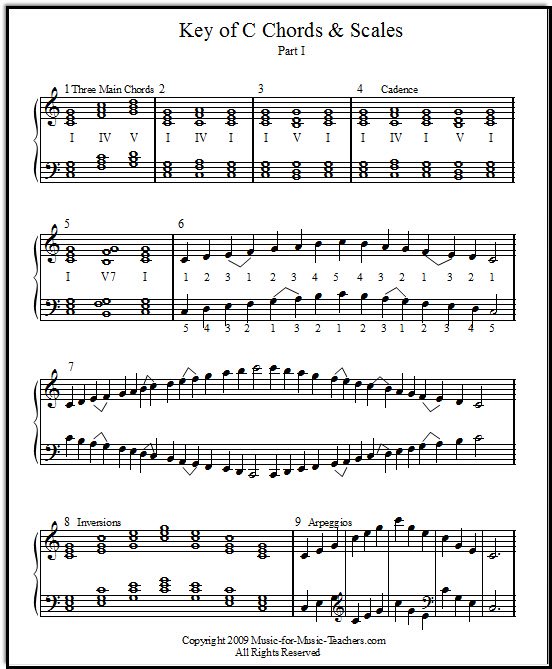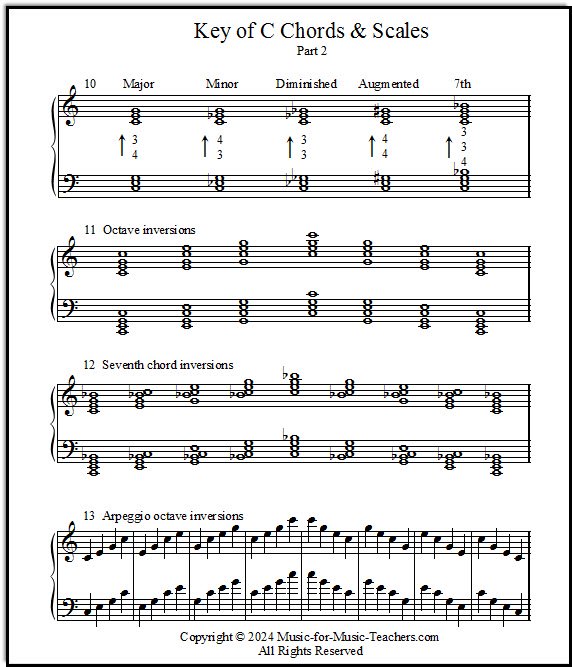
12 major scales and chord groups for piano players: free, printable download.
Now with Part 2 for more advanced students.


Please scroll down the page for the download links.
I only have the Key of C finished for Part 2, but plan to get all the others up soon!
Those arrows indicate to count UP by half-steps the number shown next to the arrow.
To make a Major chord: Start with any key (as shown here, "C," which is known as the "tonic" when in the key of C, hold that key, then count up 4 half-steps to find the next note of the chord, hold onto it, and then count up 3 more half-steps to find the next note in the C major chord.
Voila! That is the "secret formula" for making any and all major chords, starting on any key of the piano.
Many students are intrigued by this process. and it unlocks one of the beautiful mysteries of music!
As a child, I had no idea how much time the exercises must have taken for her to write -- for all of those keys, too! -- but even then, I appreciated and enjoyed playing these patterns.
There seemed something a bit magical and comforting in this routine: playing a pattern in one key, and then repeating it in another key, necessarily adjusting hand position and utilizing different fingering choices, getting the same overall sound, but with a sudden freshness.
My piano teacher wrote out all 12 major scales, chord progressions, cadences, chord inversions and arpeggios for me when I was a little girl. But she did it by hand! There were no copy machines, no computers, back then. how spoiled we've become.
I always begin assigning the 12 major scales and chords with the "Key of C" sheet.
This won't be until my piano students are able to read the chord notes in the first measure (number 1) - or until they NEED to be able to play chord inversions and the octave scale, in which case I'll give them the Basic Chords & Scales sheet , with lettered notes.
We don't move in a hurry -- on their assignment sheet, I will write "Key of C sheet, #1," week after week, until they can do it quickly with no prompting.
Soon, their assignment sheet will say,
"Key of C sheet, #2, #3, #4."
Eventually, they will drop the easiest numbers off their assignment and pick up the harder techniques, such as chord inversions and arpeggios:
My students are always eager to start regular full-octave scales, perhaps because I don't introduce them early, but spend lots of time on pentatonic scales, and perhaps because they know REAL MUSICIANS practice scales.
You may wonder why I have written the 2-octave scales in mirror fashion, with the hands moving in contrary motion instead of parallel.
Well, using matching fingering "1-2-3, 1-2-3-4, (tuck under) 1-2-3 etc." is a very easy way to learn a hands-together C scale initially. (And the page didn't look as nice with crowded fingering when I initially laid it out with parallel scales!)
With the 1-octave scale, this is how I first approach hands together, so they can have the fun of achieving speed and coordination over the "big stretch" even in the initial stages of learning where to tuck under and cross over.
Of course, this becomes much harder in the later scales, when black notes enter the picture!
Students think the contrary-motion scales are fun, because the fingering is the same, and they can achieve speed and facility quickly. I think the contrary-motion scales are fun, too.
The concept of the I, IV and V chords seems obvious to piano teachers who've been thinking that way for years, but the connections aren't at all apparent to some young students.
I try to keep reinforcing their grasp of the theory of "chord families" by coming at it from different angles, such as playing "Louie Louie" , but using major chords only (the real version has one minor chord).
When they have memorized it, then we start it again in a different key! Same thing with Twinkle , Mary Had a Little Lamb , and others.
One favorite way to talk about "The Three Main Chords" is to play the regular scale slowly with a left-hand finger, while making matching chords in the right hand.
Both hands move up the octave as I say, "The one chord, the two chord, three chord, four chord. " etc.
Then I ask them to do it. (And usually I say nothing about the chord on the seventh step of the scale and how it is different from all the rest; that would be too much information at this time!) The "Key of _________ Part 2" sheet will answer the mystery of what that penultimate chord is - a diminished chord.
And my favorite way to actually drum the 3 main chords into their fingers (and brains) is to use an energetic song.
Louie Louie Wannabe is my favorite. Louie Louie does make an impact, and stays with them, as long as I occasionally prompt them. I have to show them the video of the original song, and that context makes it even more fun.
Students will move on to the other keys before they have finished the full page of C. Two-octave scales, chord inversions and arpeggios will wait until they seem appropriate.
You may not agree with every one of my arpeggio or scale fingerings. I put down the ones I want my students to be familiar with first, what I consider "standard." When they apply scales and arpeggios in actual music, there will be exceptions to the rule!
Certainly there are times when it is advisable to choose "5, 4, 2, 1" for left-hand arpeggio fingering, but I consider it the exception to the rule.
Judith, in Canada, suggests starting with finger 2 when playing all-white note arpeggios in the right hand:
"Try starting all white note arpeggios with 2nd finger in the right hand instead of 1st finger; This eliminates reaching a 4th when turning 1st finger under and replaces it with a 3rd.
"I always allow my students to experiment to find which fingering fits their hand best.
"For me the basic rule of fingering is that it must be logical and the hand must move smoothly; as long as students follow that guideline, they can use any fingering they wish.
"Just a little note: B Major and B minor are awkward arpeggios, no matter which fingering is used."
Just cross my fingering out if you want something different.
I hope you find these 12 major scales and chords sheets useful in your music studio!
The links for the scale downloads, in alphabetical order: